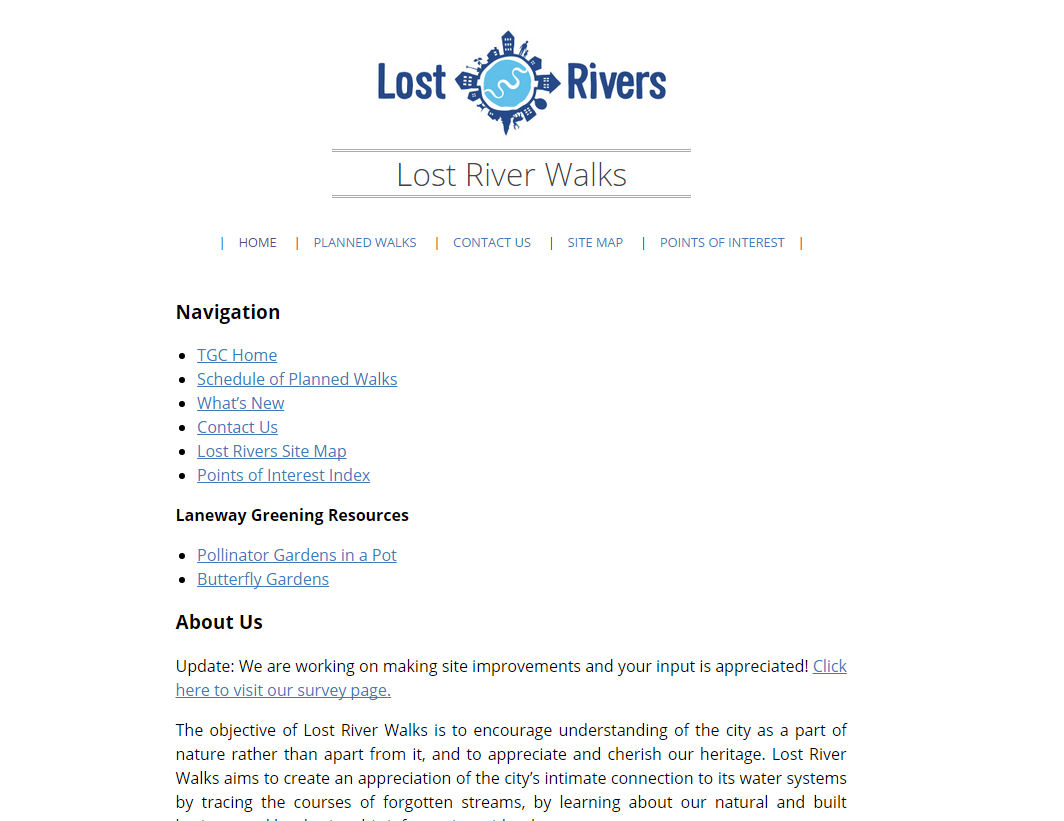One league under the Annex
Plans afoot to celebrate our buried city
By Tom G. Kernaghan
The last time you took a stroll, you may not have been aware you were walking over history. Maybe you saw some evidence of Toronto’s lost rivers, but didn’t know it: dead end streets, flooded basements, tilting houses, oddly shaped parks, dips in the road.
Buried under our streets and buildings, and contained in the city’s sewer system, are dozens of rivers, creeks, and tributaries. Created by massive glacial retreat 12,000 years ago, rivers used to run through wide ravines back when our city was called “Muddy York.”
But, rapid growth during the 19th century changed the landscape. As the population density grew, the creeks became so polluted they had to be buried under landfill, and were often converted into storm sewers. Sprawling development put them further out of sight and mind, almost for good.
“I developed an obsession to do something,” said Helen Mills, an early member of Lost River Walks, a joint citizens’ initiative between the North Toronto Green Community, Toronto Field Naturalists, and Hike Ontario that since 1995 has been leading walks along lost river routes to educate people about our city’s natural history and our relationship with water.
“We want people to discover and appreciate water,” said Mills. “And we want people to realize there is no door at the edge of ravines where ecosystems end and the city begins…. Knowing about the lost rivers gives people a whole different sense of place.”
Lost River Walks will step up its efforts this fall when it celebrates the group’s 10th anniversary with the cooperation of the Toronto Public Space Committee (TPSC), a group dedicated to the shared use of public space.
TPSC will conduct “Down by the River” walk on Sept. 18, tracing the path of the former Garrison Creek, which ran from St. Clair Avenue through Christie Pits and to Fort York, after which the river was named. Meanwhile, on Sept. 25 and 26, Lost River Walks will follow the former Mud Creek, which ran from Downsview through to the Don Valley.
The groups’ members said they hope their united effort will cultivate awareness and appreciation for the city’s lost watersheds, and generate an understanding that our treatment of them in the past has an impact that still reverberates today.
“The lost rivers represent the conflict between progress and development and trying to maintain our natural environment,” said Dave Meslin, coordinator with TPSC. “They represent what was lost.” He added the TPSC team will wear blue shirts in honour of water, to form a “human river” along Garrison Creek’s former route, and will hand out flyers asking residents to join the parade.
“We want people to look beyond their houses and think about public space,” said Meslin. “We want to celebrate the things we commonly own.”
While celebration is possible, restoration is another matter. Despite years of debate over rivers like Taddle Creek, which ran through the Annex and is now just a trickle through Philosopher’s Walk at the University of Toronto (U of T), most people accept that lost rivers will stay buried.
“These rivers were buried to be built upon,” said Nick Eyles, professor of geology at U of T. “There is limited opportunity to take it back to what it was.”
As Peter Hare, a member of Lost River Walks, said, “we have talked of restoring, but it is for all practical purposes impossible.”
The restoration is also an ecological non-starter, due to the human waste and garbage that were often buried in the rivers. Current efforts are focusing on developing new methods, such as tree planting and water conservation, of interacting with the green spaces that remain.
“It’s about how we can reinvent systems that are friendly to nature and to us,” said Mills, who is leading the Mud Creek walks, which she hopes will involve environmentally inspired artwork and picnics on route.
“The lost rivers seem to have a magnetic power for people,” she continued, adding the regular walks attract upwards of 1000 people per year. She believes public concern is rising, but noted people aren’t always sure how to get involved. “Find a small community group and get information and support,” she advises. “Small [behavioural] changes are important.”
For more information, visit http://lostrivers.ca/ or contact Dave Meslin at 416-654-TPSC, or via http://publicspace.ca/
(Gleaner News, Toronto)

